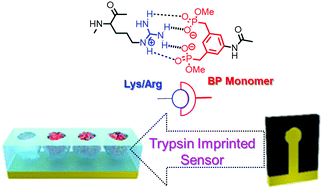当前位置:
X-MOL 学术
›
New J. Chem.
›
论文详情
Our official English website, www.x-mol.net, welcomes your
feedback! (Note: you will need to create a separate account there.)
Bisphosphonate ligand mediated ultrasensitive capacitive protein sensor: complementary match of supramolecular and dynamic chemistry†
New Journal of Chemistry ( IF 2.7 ) Pub Date : 2018-12-04 00:00:00 , DOI: 10.1039/c8nj05238g Gizem Ertürk 1, 2, 3, 4, 5 , Maedeh Akhoundian 1, 2, 3, 4, 5 , Kyra Lueg-Althoff 6, 7, 8, 9 , Sudhirkumar Shinde 1, 2, 3, 4, 5 , Sing Yee Yeung 1, 2, 3, 4, 5 , Martin Hedström 5, 10, 11, 12, 13 , Thomas Schrader 6, 7, 8, 9 , Bo Mattiasson 5, 10, 11, 12, 13 , Börje Sellergren 1, 2, 3, 4, 5
New Journal of Chemistry ( IF 2.7 ) Pub Date : 2018-12-04 00:00:00 , DOI: 10.1039/c8nj05238g Gizem Ertürk 1, 2, 3, 4, 5 , Maedeh Akhoundian 1, 2, 3, 4, 5 , Kyra Lueg-Althoff 6, 7, 8, 9 , Sudhirkumar Shinde 1, 2, 3, 4, 5 , Sing Yee Yeung 1, 2, 3, 4, 5 , Martin Hedström 5, 10, 11, 12, 13 , Thomas Schrader 6, 7, 8, 9 , Bo Mattiasson 5, 10, 11, 12, 13 , Börje Sellergren 1, 2, 3, 4, 5
Affiliation

|
Modern healthcare demands rapid and accurate detection of proteins/enzymes at the ultratrace level. Herein we present a molecularly imprinted capacitive sensor for trypsin, developed by microcontact imprinting. High affinity and selectivity was achieved by doping the prepolymerization mixture with a stoichiometric amount of methacrylamide-based bisphosphonate (BP) monomer. Taking advantage of the specific interaction between bisphosphonate binding monomers and lysine/arginine residues on the surface of trypsin, we have constructed a powerful polymeric sensor. The BP based sensor has the ability to recognize trypsin over other arginine-rich proteins, even in high ionic strength buffers with a sub-picomolar detection limit (pM). We believe that the combination of supramolecular chemistry, molecular imprinting and advanced instrumentation has a potential for future drug development and diagnostics that extends beyond biomolecular recognition.
中文翻译:

双膦酸酯配体介导的超灵敏电容蛋白传感器:超分子与动态化学的互补匹配†
现代医疗保健需要在超痕量水平上快速准确地检测蛋白质/酶。本文中,我们介绍了一种通过微接触压印开发的用于胰蛋白酶的分子压印电容式传感器。通过将化学计量的甲基丙烯酰胺基双膦酸酯(BP)单体掺杂到预聚合混合物中,可以实现高亲和力和选择性。利用双膦酸酯结合单体与胰蛋白酶表面上的赖氨酸/精氨酸残基之间的特异性相互作用,我们构建了一个功能强大的聚合物传感器。基于BP的传感器能够识别胰蛋白酶,而不是其他富含精氨酸的蛋白质,即使在具有亚皮摩尔检测极限(pM)的高离子强度缓冲液中也是如此。我们认为,超分子化学的结合
更新日期:2018-12-04
中文翻译:

双膦酸酯配体介导的超灵敏电容蛋白传感器:超分子与动态化学的互补匹配†
现代医疗保健需要在超痕量水平上快速准确地检测蛋白质/酶。本文中,我们介绍了一种通过微接触压印开发的用于胰蛋白酶的分子压印电容式传感器。通过将化学计量的甲基丙烯酰胺基双膦酸酯(BP)单体掺杂到预聚合混合物中,可以实现高亲和力和选择性。利用双膦酸酯结合单体与胰蛋白酶表面上的赖氨酸/精氨酸残基之间的特异性相互作用,我们构建了一个功能强大的聚合物传感器。基于BP的传感器能够识别胰蛋白酶,而不是其他富含精氨酸的蛋白质,即使在具有亚皮摩尔检测极限(pM)的高离子强度缓冲液中也是如此。我们认为,超分子化学的结合











































 京公网安备 11010802027423号
京公网安备 11010802027423号